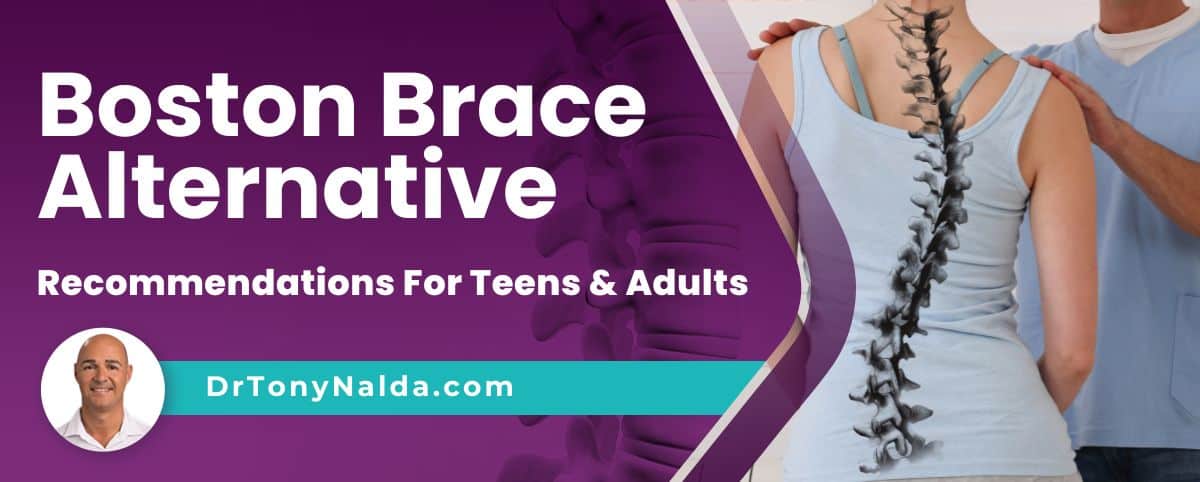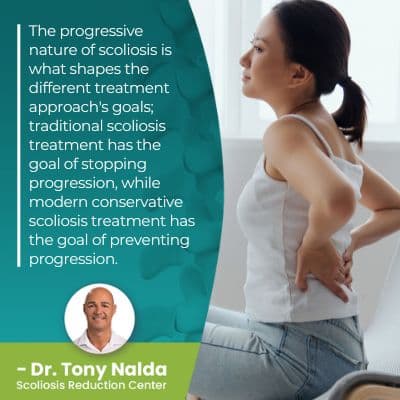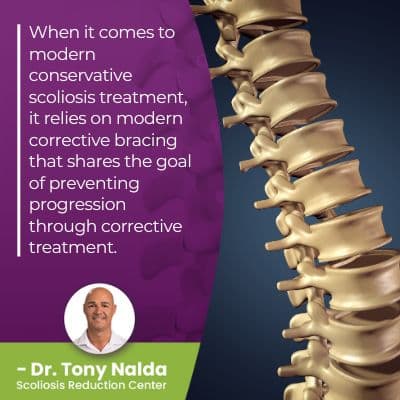Boston Brace Alternative: Recommendations For Teens & Adults

While no single brace on its own is enough to treat scoliosis, when integrated into a proactive treatment plan that combines multiple scoliosis-specific treatment disciplines, it can augment corrective treatment results. There is an important distinction to be made, however, between modern corrective bracing and traditional scoliosis bracing.
Scoliosis bracing has been a form of scoliosis treatment for many years, but patients need to understand that not all braces are created equal; different braces favored by different treatment approaches offer different potential results.
As each of the two main scoliosis treatment approaches has a type of bracing that's aligned with their treatment goal, let's explore the difference between a traditional and conservative treatment approach.
Table of Contents
Scoliosis Treatment Approaches
 Scoliosis is a progressive condition, meaning its nature is to get worse over time, and this is why the type of treatment chosen is so important; only a proactive treatment approach can work towards counteracting the condition's progressive nature.
Scoliosis is a progressive condition, meaning its nature is to get worse over time, and this is why the type of treatment chosen is so important; only a proactive treatment approach can work towards counteracting the condition's progressive nature.
When a patient is diagnosed, they need to understand that as an incurable condition, treatment is more about managing an ongoing condition than it is about reaching a permanent cure.
The progressive nature of scoliosis is what shapes the different treatment approach's goals; traditional scoliosis treatment has the goal of stopping progression, while modern conservative scoliosis treatment has the goal of preventing progression.
Traditional Scoliosis Treatment
Traditional scoliosis treatment can be described as reactive because it focuses on reacting to scoliosis progression once a certain level has already occurred, but it does little to prevent progression from occurring in the first place.
Scoliosis ranges widely in severity from mild to moderate and severe to very severe scoliosis, and this is also the condition's progressive line.
While most cases of scoliosis are idiopathic, meaning cause unknown, we do know what triggers scoliosis to progress and that's growth; once skeletal maturity is reached in adulthood, progressive rates slow, but treatment is still important.
There are never treatment guarantees, but particularly with early detection and intervention, scoliosis can be highly treatable, and scoliosis is the simplest to treat when mild; the more severe a condition, the more complex it is to treat, and adults also have natural age-related spinal degeneration to factor in.
Even adolescents recently diagnosed with mild adolescent idiopathic scoliosis are commonly told to merely watch and wait for more progression, but as a progressive condition, we know that virtually all cases are going to get worse at some point, and adolescents are the most at risk for rapid progression due to the unpredictable growth spurts of puberty.
Watching and waiting can be dangerous when it comes to treatment success because if a significant growth spurt triggers significant progression, this means the condition has been allowed to progress unimpeded, making it more complex to treat, and the condition's effects have become more established.
Traditional scoliosis treatment doesn't have a strategy for addressing scoliosis while mild, but when/if a patient progresses into the severe classification, they become a surgical candidate, and spinal fusion is commonly prescribed.
The only type of treatment applied under a traditional approach, prior to surgical intervention, is traditional bracing, known to have a number of shortfalls.
Traditional Bracing: Boston Brace
There are different types of traditional scoliosis braces, but the most commonly prescribed is the boston brace.
 The boston brace is made from rigid plastic and wraps around the torso with the goal of stopping the spine from becoming more unnaturally bent.
The boston brace is made from rigid plastic and wraps around the torso with the goal of stopping the spine from becoming more unnaturally bent.
The boston brace uses a type of three-point pressure system to apply targeted pressure along the scoliotic curve, but this type of squeezing pressure is known to weaken the spine, causing more long-term issues.
In addition, the main shortcoming associated with the boston brace is that it ignores the condition's rotational component, addressing it as 2-dimensional, rather than the 3-dimensional spinal condition that it is.
Considering the condition's most prevalent type is adolescent idiopathic scoliosis, and braces are used most often for this age group, compliance is a key issue, and as the boston brace isn't fully customized to suit a patient's body/curvature type, it's more bulky, uncomfortable to wear, and noticeable; compliance issues are common.
When it comes to bracing for adult scoliosis, the focus is more about pain reduction and improving spinal stability than stopping progression, but traditional bracing used for treating adult scoliosis has the same limitations as when used in childhood scoliosis treatment.
When it comes to modern conservative scoliosis treatment, it relies on modern corrective bracing that shares the goal of preventing progression through corrective treatment.
Conservative Scoliosis Treatment
Here at the Scoliosis Reduction Center, my scoliosis patients benefit from a proactive treatment approach that's started as close to the time of diagnosis as possible; this is when conditions are going to be at their mildest and most responsive to treatment.
As the goal of modern conservative treatment is to correct scoliosis and prevent progression, its approach is more proactive than reactive.
By starting treatment early in a condition's progressive line, the spine is going to be more flexible and responsive, and the condition's effects are also likely to be mild and simpler to reverse.
The main type of scoliosis effect in children is postural deviation, and the main symptom of adult scoliosis is pain; scoliosis doesn't become a compressive condition until skeletal maturity has been reached.
It's far more effective to proactively work towards preventing progression and increasing effects, than it is to work towards reversing those effects once they're well established and the spine is more rigid due to the size of the unnatural spinal curve increasing.
Conservative treatment doesn't wait, and it also involves the integration of multiple different scoliosis-specific treatment disciplines so conditions are impacted on every level.
Conservative treatment combines the power of chiropractic care, physical therapy, scoliosis-specific exercises (SSEs), corrective bracing, and rehabilitation, and patients can access these different forms of treatment under one roof.
Corrective Bracing: ScoliBrace
Scoliosis braces can complement other forms of treatment, and when it comes to corrective bracing, we're talking about working towards corrective results, and corrective scoliosis treatment results means impacting the condition on a structural level, first and foremost.
While chiropractic care is applied with the goal of adjusting the position of the curve's most-tilted vertebrae back into alignment with the rest of the spine, physical therapy complements these structural results through increasing spinal support and stabilization by strengthening the spine's surrounding muscles.
Corrective bracing is known as particularly effective on growing spines that are more malleable, and here at the Center, I prefer modern corrective bracing that represents the culmination of what we've learned about scoliosis and scoliosis braces over the years.
Wearing a corrective brace for scoliosis means it offers corrective potential, and the ScoliBrace addresses many of the shortcomings associated with traditional bracing, becoming the ideal boston brace alternative.
The ScoliBrace addresses the condition's rotational component, so treats it as the complex 3-dimensional spinal condition it is, and instead of applying intense squeezing pressure known to weaken an already-vulnerable spine, corrective bracing pushes the spine into a corrective position: augmenting corrective treatment results.
Compliance rates are also greatly improved with the ScoliBrace because each brace is fully customized to suit a patient's body and scoliosis curvature type, and no brace, regardless of its design, can be effective if it's not worn exactly as prescribed.
Adults can benefit from a ScoliBrace for its corrective potential, and it can also be used to make the spine more stable, and to provide short-term pain relief; when treating adult scoliosis, the focus is still on achieving a curvature reduction, but isn't so much about working towards a significant counteractive curvature reduction as it is about reducing curves back to where they were prior to becoming painful.
So a scoliosis brace that's corrective doesn't only help through its corrective potential, but also in the treatment approach that it's associated with: modern conservative scoliosis treatment.
The reality is that many cases of scoliosis don't require surgery, and when combined with other types of proactive and corrective scoliosis treatment disciplines, a corrective scoliosis brace can be a powerful boston brace alternative.
Conclusion
Young patients recently diagnosed with scoliosis don't want to stand out; they want to fit in with their peers, look the same, walk the same, and feel the same.
Unfortunately, living with a progressive spinal condition does make adolescents different; common effects include postural deviation and disruptions to balance, coordination, and gait.
When you add wearing a brace for scoliosis as a part of treatment, scoliosis treatment can be a challenge.
Being aware of the different scoliosis treatment approaches and scoliosis brace options can help minimize the challenges of scoliosis treatment by making an informed treatment choice that minimizes the condition's challenging effects.
Scoliosis is a complex condition that necessitates the full customization of effective treatment plans, and this involves integrating multiple types of treatment that can be apportioned and adjusted accordingly, based on how a patient's spine is responding to treatment and growth.
While a back brace for scoliosis is most commonly used when treating scoliosis in children because scoliosis treatment has to counteract the constant progressive trigger of growth, and growing spines are going to be more responsive to bracing, bracing is still a facet of treatment for adult scoliosis, and the pros and cons of traditional vs corrective bracing still apply.
The traditional boston brace is limited in its potential efficacy because of its shortcomings and the treatment approach it's associated with (at least in terms of avoiding invasive spinal surgery and preventing progression), but the modern corrective ScoliBrace is aligned with the goal of achieving corrective treatment results, preventing progression, and avoiding surgical recommendations; it has become an ideal boston brace alternative for patients interested in a more proactive and less-invasive scoliosis treatment approach.
When it comes to scoliosis bracing, my best recommendation for teens and adults is to first ensure they fully understand the differences between the two main scoliosis treatment approaches, and then to further ensure they are happy with the aligned brace choice of each approach.
Dr. Tony Nalda
DOCTOR OF CHIROPRACTIC
After receiving an undergraduate degree in psychology and his Doctorate of Chiropractic from Life University, Dr. Nalda settled in Celebration, Florida and proceeded to build one of Central Florida’s most successful chiropractic clinics.
His experience with patients suffering from scoliosis, and the confusion and frustration they faced, led him to seek a specialty in scoliosis care. In 2006 he completed his Intensive Care Certification from CLEAR Institute, a leading scoliosis educational and certification center.
About Dr. Tony Nalda
 Ready to explore scoliosis treatment? Contact Us Now
Ready to explore scoliosis treatment? Contact Us Now





